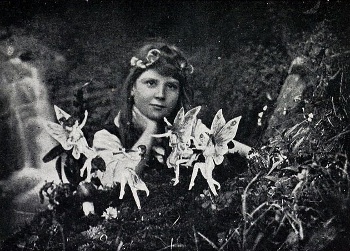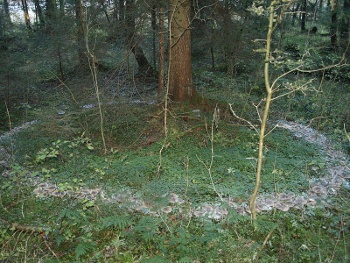Fairy Rings and Fairy Circles
June 20, 2014
The
idea that there are small,
intelligent,
magical creatures inhabiting our
woodlands has been with us throughout
history. The Greeks had their
nymphs (νυμφη), who resembled our modern
fairies except for their lack of
wings. The nymphs make an appearance in the memorable
onomatopoeic passage in
Vergil's Aeneid, Book IV, ll. 165-72, "summoque ulularunt vertice nymphae,"[1-2] in which they were howling in frenzy at what was happening in an
African cave during a
thunderstorm.
What was happening was some
lovemaking between
Aeneas, founder of
Rome,
hero of the
Trojan War, and
Dido,
queen of
Carthage. As an example that
gender inequality has deep roots, it was permissible for Aeneas to
sow some wild oats, but Dido's shame over this event, coupled with Aeneas' departure, caused her
suicide.
After the
invention of
photography, people were less inclined to believe in
folk tales; instead, everyone wanted "
photographic evidence." In the case of fairies, that photographic evidence was the 1917
photograph of the
Cottingley Fairies, as shown below. To people accustomed to today's
photoshopped images, this photograph is obviously faked, but
Arthur Conan Doyle, who was a
spiritualist, thought that it was genuine. This, and similar photographs, were staged with
cardboard cutouts of fairies.

The Cottingley Fairies
(Photograph by Kristian Nordestgaard of a news article in The Strand Magazine, 1920, via Wikimedia Commons.)
Disney successfully
commercialized fairies in its depiction of
Tinker Bell, and
girls are now outfitting themselves with wings, as fairies have hit the
cable television channels in a big way. Just as there are things named
nymphs in
biology, there are quite a few things named after fairies. There are
fairy chess pieces; the
Fairy Tern and its avian cousin, the
Fairy Warbler;
fairy shrimp;
fairy rings, and
fairy circles.
Fairy rings are naturally occurring rings of
mushrooms, typically several
yards in
diameter. In many cases, the ring will be incomplete, instead forming an
arc. These may occur in association with a
tree, as shown in the photograph, or exist in isolation. The reason for
circle forming is unclear, but it's recognized that the cause is below
ground, where
fungal mycelium are present.

Fairy ring near Buchenberg, Bavaria, Germany.
The mushrooms are Clitocybe nebularis.
(Photo by Josimda, via Wikimedia Commons.)
Shakespeare, who knew how to capture the attention of his
audience through incorporation of popular
mythology, wrote about fairy circles in
The Tempest, Act V, Scene 1,
"...You demy-Puppets, that
By Moone-shine doe the greene sowre Ringlets make,
Whereof the Ewe not bites: and you, whose pastime
Is to make midnight-Mushrumps, that reioyce
To heare the solemne Curfewe..."[3]
Similar to fairy rings, but even more curious, are fairy circles. These are circular patches of barren ground up to about fifty
feet in diameter in an otherwise lush
grassland (see photographs, below). These occur in the African countries of
Namibia,
Angola and
South Africa. Unlike fairy rings, which are persistent and maintain the same dimension, fairy circles evolve. They grow in diameter and then finally disappear, being filled in with the surrounding grass
species. Their origin remains unknown, even after thirty years of
research.[4]

Fairy circles in the Marienfluss Valley, Namibia. The average diameter of fairy circles in that region is about six meters. (left image by Thorsten Becker and right image by Stephan Getzin, via Wikimedia Commons.)
An international team of
scientists from the
Helmholtz Centre for Environmental Research (UFZ, Leipzig, Germany), the
University of Göttingen (Göttingen, Germany),
Ben-Gurion University (Beer Sheva, Israel), the
Dead Sea and Arava Science Center (Tamar Regional Council, Israel), and
ISAC-CNR (Torino, Italy) has taken a different approach to identifying the cause of these fairy circles. They've used
image analysis of
aerial photographs to examine the
spatial patterns of the fairy circles, which number in the millions in the
Namib Desert.[4-5]
Stephan Getzin, an
author of the study from the Helmholtz Centre for Environmental Research, says that "although scientists have been trying to answer this question for decades, their mystery remains as yet unresolved," the principal reason being that no one has observed the formation and evolution of these fairy circles.[5] The most popular
theory has been that they are caused by
termites that eat the
grass roots. Another theory is that
gas emission from processes below ground cause the disappearance of
vegetation.[5]
An article published in
Science in 2013 concluded that the
sand termite,
Psammotermes allocerus, was responsible, since this species was present at all the fairy circles investigated.[6-7] However, termite
grazing actually resulting in circles was not observed.[5] One other theory of fairy circle formation is based on the observation that the circles appear in transition regions between grassland and
desert. At such places, vegetation would compete for
water resources, and this could lead to bare patches with lush peripheral grass rings.[5]
The present study did a pattern analysis of the different spatial features of the fairy circles and compared this to what would be expected from the various generation
hypotheses.[4,5] The analysis was done on representative 25-
hectare aerial images of
northwest Namibia with the goal of answering the following questions.[4,5]
• Are they arranged and positioned by chance?
• Are there signs or distinguishable patterns of clustering in certain locations?
• Do the fairy circles maintain a minimum distance to their nearest neighbors?
A regular and homogeneous
distribution pattern across large areas was detected by the
computer analysis, although it was not visible by
eye.[5] Says Getzin, "There must be particularly strong regulating forces at work".[5] The pattern was characterized by
Voronoi cells, mostly with six corners, and negative
correlations in size up to a distance of 13
meters.[4] This finding effectively disproves the termite and underground gas theories.[4,5]
The most probable cause for the fairy circles is water-resource
competition among plants and vegetation, which would create the observed distribution.[4,5] As confirmation, the research team developed a
mathematical model of how such competition would occur. The model generated spatial patterns like those observed.[4,5]
References:
- Virgil's Aeneid, Latin text, Project Gutenberg.
- John Dryden, Virgil's Aeneid, English translation, Project Gutenberg.
- William Shakespeare, "The Tempest," from the first folio, Project Gutenberg.
- Stephan Getzin, Kerstin Wiegand, Thorsten Wiegand, Hezi Yizhaq, Jost von Hardenberg and Ehud Meron, "Adopting a spatially explicit perspective to study the mysterious fairy circles of Namibia," Ecography (May 20, 2014), doi: 10.1111/ecog.00911.
- Fairy circles apparently not created by termites after all, Helmholtz Centre for Environmental Research Press release, May 20, 2014.
- Norbert Juergens, "The Biological Underpinnings of Namib Desert Fairy Circles," Science, vol. 339, no. 6127 (March 29, 2013), pp. 1618-1621.
- Jonathan Amos, "Termites 'engineer fairy circles'," BBC News, March 28. 2013.
Permanent Link to this article
Linked Keywords: Idea; intelligence; intelligent; magic; magical; creature; woodland; history; nymph; fairy; fairies; wing; onomatopoeia; onomatopoeic; Vergil; Aeneid; Africa; African; cave; thunderstorm; lovemaking; Aeneas; Rome; hero; Trojan War; Dido; queen; Carthage; gender inequality; sowing wild oats; suicide; invention; photography; traditional story; folk tale; photograph; photographic; evidence; Cottingley Fairies; hoto manipulation; photoshopping; Arthur Conan Doyle; spiritualism; spiritualist; cardboard; Wikimedia Commons; The Walt Disney Company; commercialization; ommercializ; Tinker Bell; girl; cable television channel; nymphs - biology; fairy chess pieces; Fairy Tern; Fairy Flycatcher; Fairy Warbler; Anostraca; fairy shrimp; fairy ring; fairy circle; mushroom; yard; diameter; arc; tree; circle; ground; fungus; fungal; mycelium<; Buchenberg; Bavaria; Germany; Clitocybe nebularis; William Shakespeare; audience; mythology; The Tempest; foo length; grassland; Namibia; Angola; South Africa; species; research; Marienfluss Valley; meter; scientist; Helmholtz Centre for Environmental Research (UFZ, Leipzig, Germany); University of Göttingen (Göttingen, Germany); Ben-Gurion University (Beer Sheva, Israel); Dead Sea and Arava Science Center (Tamar Regional Council, Israel); Consiglio Nazionale delle Ricerche; ISAC-CNR (Torino, Italy); image analysis; aerial photograph; spatial; pattern; Namib Desert; Stephan Getzin; author; theory; termite; grass; root; gas; vegetation; Science journal; sand; Psammotermes allocerus; grazing; desert; water resources; hypotheses; hectare; northwest; randomness; chance; probability distribution; distribution pattern; computer; eye; Voronoi cell; correlation; meter; competition; mathematical model; Project Gutenberg.